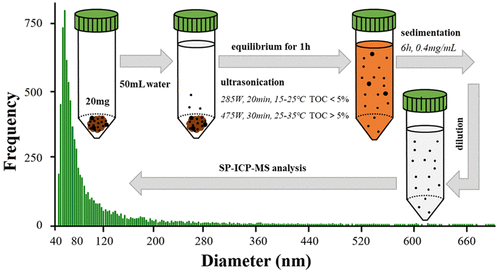当前位置:
X-MOL 学术
›
Environ. Sci. Technol.
›
论文详情
Our official English website, www.x-mol.net, welcomes your
feedback! (Note: you will need to create a separate account there.)
Simple Method for the Extraction and Determination of Ti-, Zn-, Ag-, and Au-Containing Nanoparticles in Sediments Using Single-Particle Inductively Coupled Plasma Mass Spectrometry
Environmental Science & Technology ( IF 10.8 ) Pub Date : 2021-07-16 , DOI: 10.1021/acs.est.1c00983 Feiyun Tou 1 , Zuoshun Niu 1 , Jiquan Fu 1 , Jiayuan Wu 1 , Min Liu 1, 2 , Yi Yang 1, 3, 4
Environmental Science & Technology ( IF 10.8 ) Pub Date : 2021-07-16 , DOI: 10.1021/acs.est.1c00983 Feiyun Tou 1 , Zuoshun Niu 1 , Jiquan Fu 1 , Jiayuan Wu 1 , Min Liu 1, 2 , Yi Yang 1, 3, 4
Affiliation

|
The quantitative analysis of nanoparticles (NPs) in the environment is significantly important for the exploration of the occurrence, fate, and toxicological behaviors of NPs and their subsequent environmental risks. Some protocols have been recommended for the separation and extraction of NPs that are potentially dispersed in complex environmental matrixes, e.g. sediments and soils, but they remain limited. However, certain factors that may significantly affect extraction efficiency have not been comprehensively explored. In this study, on the basis of the single-particle inductively coupled plasma mass spectrometry (SP-ICP-MS) technique, a simple standardized protocol for separating and analyzing metal-containing NPs in sediment samples was developed. On consideration of the extraction efficiencies of indigenous NPs (Ti- and Zn-NPs) and spiked NPs (Ag- and Au-NPs) in sediments, sedimentation with a settling time of 6 h is recommended for the separation of NPs and large particles, and the optimal sediment to water ratio, ultrasonication power, time, and temperature are 0.4 mg/mL, 285 W, 20 min, and 15–25 °C, respectively. On the basis of the optimized method, the recoveries of spiked Ag and Au-NPs were 71.4% and 81.1%, respectively. The applicability of the optimal protocols was verified, and TOC was proved to be an important factor controlling the separation and extraction of NPs in environmental samples. The separation and extraction of NPs in elevated TOC samples can be improved by increasing the ultrasonication power, time, and temperature.
中文翻译:

使用单粒子电感耦合等离子体质谱法提取和测定沉积物中含钛、锌、银和金的纳米粒子的简单方法
环境中纳米颗粒(NPs)的定量分析对于探索纳米颗粒的发生、归宿和毒理学行为及其后续环境风险具有重要意义。一些协议已被推荐用于分离和提取可能分散在复杂环境基质(例如沉积物和土壤)中的 NP,但它们仍然有限。然而,某些可能显着影响提取效率的因素尚未得到全面探讨。在本研究中,基于单粒子电感耦合等离子体质谱 (SP-ICP-MS) 技术,开发了一种用于分离和分析沉积物样品中含金属纳米粒子的简单标准化方案。考虑到沉积物中原生 NPs(Ti-和 Zn-NPs)和加标 NPs(Ag-和 Au-NPs)的提取效率,推荐沉降时间为 6 小时的沉淀用于分离 NPs 和大颗粒,最佳泥水比、超声处理功率、时间和温度分别为 0.4 mg/mL、285 W、20 min 和 15–25 °C。在优化方法的基础上,加标 Ag 和 Au-NPs 的回收率分别为 71.4% 和 81.1%。验证了优化方案的适用性,证明 TOC 是控制环境样品中 NPs 分离和提取的重要因素。通过增加超声处理功率、时间和温度,可以改善 TOC 升高样品中纳米颗粒的分离和提取。建议沉淀时间为 6 小时,用于分离纳米颗粒和大颗粒,最佳沉水比、超声功率、时间和温度为 0.4 mg/mL、285 W、20 分钟和 15-25 ℃,分别。在优化方法的基础上,加标 Ag 和 Au-NPs 的回收率分别为 71.4% 和 81.1%。验证了优化方案的适用性,证明 TOC 是控制环境样品中 NPs 分离和提取的重要因素。通过增加超声处理功率、时间和温度,可以改善 TOC 升高样品中纳米颗粒的分离和提取。建议沉淀时间为 6 小时,用于分离纳米颗粒和大颗粒,最佳沉淀水比、超声功率、时间和温度为 0.4 mg/mL、285 W、20 分钟和 15-25 ℃,分别。在优化方法的基础上,加标 Ag 和 Au-NPs 的回收率分别为 71.4% 和 81.1%。验证了优化方案的适用性,证明 TOC 是控制环境样品中 NPs 分离和提取的重要因素。通过增加超声处理功率、时间和温度,可以改善 TOC 升高样品中纳米颗粒的分离和提取。分别为 4 mg/mL、285 W、20 分钟和 15–25 °C。在优化方法的基础上,加标 Ag 和 Au-NPs 的回收率分别为 71.4% 和 81.1%。验证了优化方案的适用性,证明 TOC 是控制环境样品中 NPs 分离和提取的重要因素。通过增加超声处理功率、时间和温度,可以改善 TOC 升高样品中纳米颗粒的分离和提取。分别为 4 mg/mL、285 W、20 分钟和 15–25 °C。在优化方法的基础上,加标 Ag 和 Au-NPs 的回收率分别为 71.4% 和 81.1%。验证了优化方案的适用性,证明 TOC 是控制环境样品中 NPs 分离和提取的重要因素。通过增加超声处理功率、时间和温度,可以改善 TOC 升高样品中纳米颗粒的分离和提取。
更新日期:2021-08-03
中文翻译:

使用单粒子电感耦合等离子体质谱法提取和测定沉积物中含钛、锌、银和金的纳米粒子的简单方法
环境中纳米颗粒(NPs)的定量分析对于探索纳米颗粒的发生、归宿和毒理学行为及其后续环境风险具有重要意义。一些协议已被推荐用于分离和提取可能分散在复杂环境基质(例如沉积物和土壤)中的 NP,但它们仍然有限。然而,某些可能显着影响提取效率的因素尚未得到全面探讨。在本研究中,基于单粒子电感耦合等离子体质谱 (SP-ICP-MS) 技术,开发了一种用于分离和分析沉积物样品中含金属纳米粒子的简单标准化方案。考虑到沉积物中原生 NPs(Ti-和 Zn-NPs)和加标 NPs(Ag-和 Au-NPs)的提取效率,推荐沉降时间为 6 小时的沉淀用于分离 NPs 和大颗粒,最佳泥水比、超声处理功率、时间和温度分别为 0.4 mg/mL、285 W、20 min 和 15–25 °C。在优化方法的基础上,加标 Ag 和 Au-NPs 的回收率分别为 71.4% 和 81.1%。验证了优化方案的适用性,证明 TOC 是控制环境样品中 NPs 分离和提取的重要因素。通过增加超声处理功率、时间和温度,可以改善 TOC 升高样品中纳米颗粒的分离和提取。建议沉淀时间为 6 小时,用于分离纳米颗粒和大颗粒,最佳沉水比、超声功率、时间和温度为 0.4 mg/mL、285 W、20 分钟和 15-25 ℃,分别。在优化方法的基础上,加标 Ag 和 Au-NPs 的回收率分别为 71.4% 和 81.1%。验证了优化方案的适用性,证明 TOC 是控制环境样品中 NPs 分离和提取的重要因素。通过增加超声处理功率、时间和温度,可以改善 TOC 升高样品中纳米颗粒的分离和提取。建议沉淀时间为 6 小时,用于分离纳米颗粒和大颗粒,最佳沉淀水比、超声功率、时间和温度为 0.4 mg/mL、285 W、20 分钟和 15-25 ℃,分别。在优化方法的基础上,加标 Ag 和 Au-NPs 的回收率分别为 71.4% 和 81.1%。验证了优化方案的适用性,证明 TOC 是控制环境样品中 NPs 分离和提取的重要因素。通过增加超声处理功率、时间和温度,可以改善 TOC 升高样品中纳米颗粒的分离和提取。分别为 4 mg/mL、285 W、20 分钟和 15–25 °C。在优化方法的基础上,加标 Ag 和 Au-NPs 的回收率分别为 71.4% 和 81.1%。验证了优化方案的适用性,证明 TOC 是控制环境样品中 NPs 分离和提取的重要因素。通过增加超声处理功率、时间和温度,可以改善 TOC 升高样品中纳米颗粒的分离和提取。分别为 4 mg/mL、285 W、20 分钟和 15–25 °C。在优化方法的基础上,加标 Ag 和 Au-NPs 的回收率分别为 71.4% 和 81.1%。验证了优化方案的适用性,证明 TOC 是控制环境样品中 NPs 分离和提取的重要因素。通过增加超声处理功率、时间和温度,可以改善 TOC 升高样品中纳米颗粒的分离和提取。











































 京公网安备 11010802027423号
京公网安备 11010802027423号